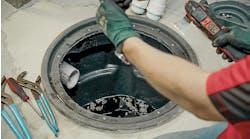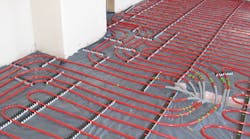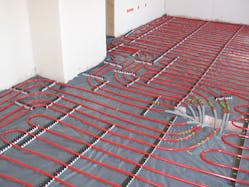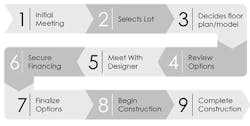In 2006, Paramount Pictures released a comedy called “Failure to Launch.” It starred Matthew McConaughey as a 30-something, single man who had all of the right qualifications for success, yet still lived at home with his mom and dad. Despite having money, good looks, all the right talents — everything — he had never left the nest. He was stuck at “Start.” His parents were so desperate to get him out of the house and on his own, they hatched a plan to light a match to launch his life. It was a really funny movie.
I think you could make this same movie for radiant heating. This technology has an outstanding pedigree of design advantages that capitalize on sustainability, unparalleled comfort, increased efficiency, improved indoor air quality, and a host of other advantages over alternative types of heating. But despite the qualifications, to be bluntly honest, it is nowhere near its potential as an industry.
Listen to what a few of the experts say about radiant heating.
- “The best heating system a house can have is the one you don't realize is there. No radiators clanking in the night. No vents whooshing like a jet preparing for take-off. No dust-spewing ductwork to run up your allergists’ bills. Just an even blanket of heat, right where you want it. That’s the appeal of radiant floor heating. It's truly invisible. But a radiant floor heating system has more than just aesthetics going for it. It’s also a highly efficient way to heat a house, increasing comfort as it reduces energy costs.” — Richard Trethewey, This Old House
- “Radiant floor heating is arguably the ideal home heating system. It’s comfortable, efficient, unobtrusive, quiet, and does not blow dust and allergens around the way forced hot-air systems do.” — Bob Vila, Bob Vila Academy
- “Radiant heating has a number of advantages. It is more efficient than baseboard heating and usually more efficient than forced-air heating because it eliminates duct losses. People with allergies often prefer radiant heat because it doesn’t distribute allergens like forced air systems can.” — U.S. Department of Energy, Energy.gov
[CHARTBEAT:3]
There are dozens and dozens of experts in the industry who feel the same way and yet, despite the overwhelmingly positive rhetoric, radiant heating is simply not growing as well as it should. In the words of Winston Churchill, “However beautiful the strategy, you should occasionally look at the results.” The results are, at best, under whelming. We have been “hatching plans” to launch radiant heating for 40 years, and it appears we are no further along than when we started.
Current state of hydronic, radiant heating
“Despite the introduction of new products, new companies and new associations, the long-term trend in market share for hydronics systems has remained flat since 1973.” — Robert Bean, RET, PL(Eng), foremost expert and conference speaker on indoor environmental quality, indoor air quality, thermal comfort, healthy heating and radiant-based HVAC.
“The current state of the radiant industry,” according to Mark Hudoba, director of heating and cooling at Uponor, “is that there is limited market penetration [2.3 percent for radiant floor heating], limited growth [limited to mid- and high-luxury homes], perceived system complexity by multiple manufacturers, positioning as a luxury amenity (not a standard HVAC system), unrealized value by the real-estate market — all of it complicated by the recent, prolonged, economic recession in the housing market.”
Meanwhile, incentives to install energy-saving equipment are being offset by a 20-year-low in oil prices. Even though housing starts have risen, inclusion of radiant heating jobs has actually shrunk as a percentage in the last 10 years according the latest data from the Census Bureau.
With that in mind, let’s take a look at why to see if there is anything we can do to change it.
First, let’s look at the housing market.But for the starter home, it’s a much different story. Radiant heat costs between $6 and $16 per square foot (sq. ft.) to install. For this example, let’s say $10/sq. ft. For the starter home, that will add $15,350 to the initial price of the home, or 10.2 percent of the total cost.
That’s quite a substantial investment for a starter home where owners are already sacrificing highly desired features, such as granite countertops and hardwood floors. In this instance, radiant becomes a wishful dream for a future home.
But following the same math, for a 5,140-sq.ft., mid-luxury home, radiant represents only a 5.6 percent initial price addition. In that price range, it is easy to see why radiant is more prevalent.
However, simplifying the system and its installation for a starter home and dropping the price to $6/sq. ft. would drop the installation cost to $9,210, or 5.9%. That figure is now closer to being in reach for the starter homeowner. At today’s mortgage loan rates, that would add about $45 per month to the mortgage. Combined with the expected monthly energy savings, it could drop the rate to about $30 per month — much more affordable.
Influence on key decisions
Now, let’s take a look at who influences the decision on the components of home building. The chart below reflects the percentage of influence based on a spec-built home from move-up to entry luxury.
You can see that if the builder is unfamiliar with radiant heating, or unsure how to bid the job or find installers, he will likely influence the homeowner away from radiant heating — or price it out of the range of consideration to protect himself.
In the starter-home sector, homeowner influence is reduced to less than 10 percent (few options allowed) and in mid- to high-luxury homes, the homeowner influence increases to up to 50 percent (many options allowed). In the case of a move-up home, for instance, the primary decision-maker (the builder) is not the beneficiary of what is being purchased and installed. There is no skin in the game to include radiant if there is no perceived benefit to the builder. Whereas in high-luxury homes, homeowners are driving the decision-making, and they are requesting radiant heat; therefore, it gets installed.
Building timelineFollowing in line with the influence on key decisions is the actual timeline of the build cycle itself. Below is a chart of a typical build cycle for a move-up or entry-level home.
Since radiant heating is usually not considered a conventional means of heating at this time, it is not until Step 4 that the possibility of radiant heating is discussed — if it is discussed at all. Step 7 is where radiant heat is typically lost due to lack of pricing or lack of time before Step 8 can commence. In many cases, foundations are poured after Step 6, which means the in-floor radiant heating cannot be installed in the slab.
So there are some hurdles to overcome, but they are not insurmountable. On the contrary, I believe radiant heating is poised to become a viable option for heating systems. More and more research is bearing out the fact that radiant heat offers real solutions to real heating issues.
So, let’s start with a few creative solutions.
Creative solutions
For radiant heat to compete in the market today, it must meet three basic standards: simple, affordable and repeatable. Without all three, the market penetration will remain with mid- and high-luxury homes and rarely enter the other home types.
To that end, making a few of these solutions part of our normal build cycle will greatly increase the position of radiant heating:
- Partial-radiant systems: Instead of installing radiant throughout the entire house, install radiant where it will provide the most comfort change, such as the basement and the master bath.
- Offer radiant as an option: One large national builder tried a test-market analysis and offered radiant heating as one of the options when building, along with cabinet upgrades, carpet upgrades, etc. Over a two-year period, this company experienced a 213 percent increase in radiant installations, and it is expanding the trial into several other markets. In the move-up and entry-level markets, radiant will probably remain an orphan until radiant heating appears as an option on the buying end.
- Install combination boilers: One of the main arguments against radiant heating is the need to install a separate boiler for the radiant system plus a forced-air furnace for the air conditioning. A combi boiler (or combination boiler) can help solve that problem. A combi boiler is both a high-efficiency water heater and a central heating boiler, combined (hence the name) into one compact unit. No separate water heater is required, thus offering a significant increase in efficiency when heating domestic hot water, while saving floor space in the mechanical room. It’s a win-win situation!
Going forward, what can we do to make radiant heat more appealing to the masses?
Besides the three creative solutions offered above, radiant heating is going to be a game-changer in the area of indoor air quality. In a future article, I will focus on this subject — it is that important. Homes are becoming tighter and tighter all the time, resulting in a skyrocketing increase of “sick building syndrome:” homes that are downright toxic for their owners.
Did you know that your carpet can hold eight times its weight in toxin-filled dirt that you can't see, no matter how much vacuuming you do?
The reason many people have carpeting to begin with is that their feet are cold. Their feet are cold because all the heat is up at the ceiling (because hot air rises). If you install radiant in-floor heating along with nice hardwood floors, you have the heat at your feet and the dust can be easily swept up. Problem solved.
There are many, many more of these indoor-air-quality issues where radiant can help. Let’s continue the dialogue on this in the near future.
One final thought. In North America, fewer than five percent of homes are heated hydronically (with hot water); the other 95 percent are heated with forced air. Yet, in the rest of the world, it is exactly the opposite: Five percent of homes are heated with forced air and 95 percent are heated hydronically.
Why is that? Simple. In the rest of the world, gas is selling for $10 per gallon, so they cannot afford forced air. In some countries, hydronic heating is mandated. It is part of their energy codes. They are not allowed to use forced air as part of their heating system. They do their cooling using mini-split systems or whole house ERVs (energy recovery ventilators).
If energy prices ever do go up in this country, it would be a really good idea to know how to install radiant heating. Just sayin’.
I would be grateful to hear your thoughts, ideas and stories. Until then, best regards and happy heating.
Steve Swanson is the customer trainer at Uponor Academy. He actively welcomes reader comments and can be reached at [email protected].







